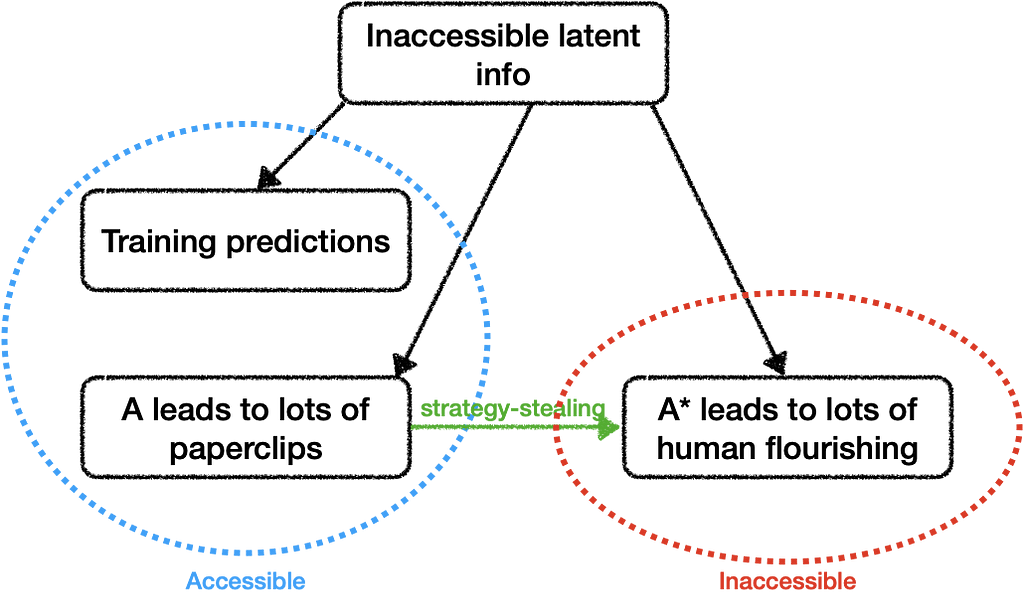
Inaccessible information
5Wei Dai
5paulfchristiano
3Vanessa Kosoy
2Rohin Shah
2evhub
3paulfchristiano
4evhub
1Raemon
1TurnTrout
1paulfchristiano
New Comment
or we need to figure out some way to access the inaccessible information that “A* leads to lots of human flourishing.”
To help check my understanding, your previously described proposal to access this "inaccessible" information involves building corrigible AI via iterated amplification, then using that AI to capture "flexible influence over the future", right? Have you become more pessimistic about this proposal, or are you just explaining some existing doubts? Can you explain in more detail why you think it may fail?
(I'll try to guess.) Is it that corrigibility is about short-term preferences-on-reflection and short-term preferences-on-reflection may themselves be inaccessible information?
I can pay inaccessible costs for an accessible gain — for example leaking critical information, or alienating an important ally, or going into debt, or making short-sighted tradeoffs. Moreover, if there are other actors in the world, they can try to get me to make bad tradeoffs by hiding real costs.
This seems similar to what I wrote in an earlier thread: "What if the user fails to realize that a certain kind of resource is valuable? (By “resources” we’re talking about things that include more than just physical resources, like control of strategic locations, useful technologies that might require long lead times to develop, reputations, etc., right?)" At the time I thought you proposed to solve this problem by using the user's "preferences-on-reflection", which presumably would correctly value all resources/costs. So again is it just that "preferences-on-reflection" may itself be inaccessible?
Overall I don’t think it’s very plausible that amplification or debate can be a scalable AI alignment solution on their own, mostly for the kinds of reasons discussed in this post — we will eventually run into some inaccessible knowledge that is never produced by amplification, and so never winds up in your distilled agents.
Besides the above, can you give some more examples of (what you think may be) "inaccessible knowledge that is never produced by amplification"?
(I guess an overall feedback is that in most of the post you discuss inaccessible information without talking about amplification, and then quickly talk about amplification in the last section, but it's not easy to see how the two ideas relate without more explanations and examples.)
To help check my understanding, your previously described proposal to access this "inaccessible" information involves building corrigible AI via iterated amplification, then using that AI to capture "flexible influence over the future", right? Have you become more pessimistic about this proposal, or are you just explaining some existing doubts? Can you explain in more detail why you think it may fail?
(I'll try to guess.) Is it that corrigibility is about short-term preferences-on-reflection and short-term preferences-on-reflection may themselves be inaccessible information?
I think that's right. The difficulty is that short-term preferences-on-reflection depend on "how good is this situation actually?" and that judgment is inaccessible.
This post doesn't reflect me becoming more pessimistic about iterated amplification or alignment overall. This post is part of the effort to pin down the hard cases for iterated amplification, which I suspect will also be hard cases for other alignment strategies (for the kinds of reasons discussed in this post).
This seems similar to what I wrote in an earlier thread: "What if the user fails to realize that a certain kind of resource is valuable?
Yeah, I think that's similar. I'm including this as part of the alignment problem---if unaligned AIs realize that a certain kind of resource is valuable but aligned AIs don't realize that, or can't integrate it with knowledge about what the users want (well enough to do strategy stealing) then we've failed to build competitive aligned AI.
(By “resources” we’re talking about things that include more than just physical resources, like control of strategic locations, useful technologies that might require long lead times to develop, reputations, etc., right?)"
Yes.
At the time I thought you proposed to solve this problem by using the user's "preferences-on-reflection", which presumably would correctly value all resources/costs. So again is it just that "preferences-on-reflection" may itself be inaccessible?
Yes.
Besides the above, can you give some more examples of (what you think may be) "inaccessible knowledge that is never produced by amplification"?
If we are using iterated amplification to try to train a system that answers the question "What action will put me in the best position to flourish over the long term?" then in some sense the only inaccessible information that matters is "To what extent will this action put me in a good position to flourish?" That information is potentially inaccessible because it depends on the kind of inaccessible information described in this post---what technologies are valuable? what's the political situation? am I being manipulated? is my physical environment being manipulated?---and so forth. That information in turn is potentially inaccessible because it may depend on internal features of models that are only validated by trial and error, for which we can't elicit the correct answer either by directly checking it nor by transfer from other accessible features of the model.
(I might be misunderstanding your question.)
(I guess an overall feedback is that in most of the post you discuss inaccessible information without talking about amplification, and then quickly talk about amplification in the last section, but it's not easy to see how the two ideas relate without more explanations and examples.)
By default I don't expect to give enough explanations or examples :) My next step in this direction will be thinking through possible approaches for eliciting inaccessible information, which I may write about but which I don't expect to be significantly more useful than this. I'm not that motivated to invest a ton of time in writing about these issues clearly because I think it's fairly likely that my understanding will change substantially with more thinking, and I think this isn't a natural kind of "checkpoint" to try to explain clearly. Like most posts on my blog, you should probably regard this primarily as a record of Paul's thinking. (Though it would be great if it could be useful as explanation as a side effect, and I'm willing to put in a some time to try to make it useful as explanation, just not the amount of time that I expect would be required.)
(My next steps on exposition will be trying to better explain more fundamental aspects of my view.)
This post defines and discusses an informal notion of "inaccessible information" in AI.
AIs are expected to acquire all sorts of knowledge about the world in the course of their training, including knowledge only tangentially related to their training objective. The author proposes to classify this knowledge into "accessible" and "inaccessible" information. In my own words, information inside an AI is "accessible" when there is a straightforward way to set up a training protocol that will incentivize the AI to reliably and accurately communicate this information to the user. Otherwise, it is "inaccessible". This distinction is meaningful because, by default, the inner representation of all information is opaque (e.g. weights in an ANN) and notoriously hard to make sense of by human operators.
The primary importance of this concept is in the analysis of competitiveness between aligned and unaligned AIs. This is because it might be that aligned plans are inaccessible (since it's hard to reliably specify whether a plan aligned) whereas certain unaligned plans are accessible (e.g. because it's comparatively easy to specify whether a plan produces many paperclips). The author doesn't mention this, but I think that there is also another reason, namely that unaligned subagents effectively have access to information that is inaccessible to us.
More concretely, approaches such as IDA and debate rely on leveraging certain accessible information: for debate it is "what would convince a human judge", and for IDA-of-imitation it is "what would a human come up with if they think about this problem for such and such time". But, this accessible information is only a proxy for what we care about ("how to achieve our goals"). Assuming this proxy doesn't produce goodharting, we are still left with a performance penalty for this indirection. That is, a paperclip maximizer reasons directly about "how to maximize paperclips", leveraging all information it has, whereas an IDA-of-imitation only reasons about "how to achieve human goals" via the information it has about "what would a human come up with".
The author seems to believe that finding a method to "unlock" this inaccessible information will solve the competitiveness problem. On the other hand I am more pessimistic. I consider it likely that there is an inherent tradeoff between safety and performance, and therefore any such method would either expose another attack vector or introduce another performance penalty.
The author himself says that "MIRI’s approach to this problem could be described as despair + hope you can find some other way to produce powerful AI". I think that my approach is despair(ish) + a different hope. Namely, we need to ensure a sufficient period during which (i) aligned superhuman AIs are deployed (ii) no unaligned transformative AIs are deployed, and leverage it to set-up a defense system. That said, I think the concept of "inaccessible information" is interesting and thinking about it might well produce important progress in alignment.
Planned summary for the Alignment Newsletter:
One way to think about the problem of AI alignment is that we only know how to train models on information that is _accessible_ to us, but we want models that leverage _inaccessible_ information.
Information is accessible if it can be checked directly, or if an ML model would successfully transfer to provide the information when trained on some other accessible information. (An example of the latter would be if we trained a system to predict what happens in a day, and it successfully transfers to predicting what happens in a month.) Otherwise, the information is inaccessible: for example, “what Alice is thinking” is (at least currently) inaccessible, while “what Alice will say” is accessible. The post has several other examples.
Note that while an ML model may not directly say exactly what Alice is thinking, if we train it to predict what Alice will say, it will probably have some internal model of what Alice is thinking, since that is useful for predicting what Alice will say. It is nonetheless inaccessible because there’s no obvious way of extracting this information from the model. While we could train the model to also output “what Alice is thinking”, this would have to be training for “a consistent and plausible answer to what Alice is thinking”, since we don’t have the ground truth answer. This could incentivize bad policies that figure out what we would most believe, rather than reporting the truth.
The argument for risk is then as follows: we care about inaccessible information (e.g. we care about what people _actually_ experience, rather than what they _say_ they experience) but can’t easily make AI systems that optimize for it. However, AI systems will be able to infer and use inaccessible information, and would outcompete ones that don’t. AI systems will be able to plan using such inaccessible information for at least some goals. Then, the AI systems that plan using the inaccessible information could eventually control most resources. Key quote: “The key asymmetry working against us is that optimizing flourishing appears to require a particular quantity to be accessible, while danger just requires anything to be accessible.”
The post then goes on to list some possible angles of attack on this problem. Iterated amplification can be thought of as addressing gaps in speed, size, experience, algorithmic sophistication etc. between the agents we train and ourselves, which can limit what inaccessible information our agents can have that we won’t. However, it seems likely that amplification will eventually run up against some inaccessible information that will never be produced. As a result, this could be a “hard core” of alignment.
Planned opinion:
I think the idea of inaccessible information is an important one, but it’s one that feels deceptively hard to reason about. For example, I often think about solving alignment by approximating “what a human would say after thinking for a long time”; this is effectively a claim that human reasoning transfers well when iterated over long periods of time, and “what a human would say” is at least somewhat accessible. Regardless, it seems reasonably likely that AI systems will inherit the same property of transferability that I attribute to human reasoning, in which case the argument for risk applies primarily because the AI system might apply its reasoning towards a different goal than the ones we care about, which leads us back to the <@intent alignment@>(@Clarifying "AI Alignment"@) formulation.
This response views this post as a fairly general argument against black box optimization, where we only look at input-output behavior, as then we can’t use inaccessible information. It suggests that we need to understand how the AI system works, rather than relying on search, to avoid these problems.
Maybe I'm missing something, but I don't understand why you're considering the output of the simplest model that provides some checkable information to be accessible. It seems to me like that simplest model could very well be implementing a policy like BAD that would cause its output on the uncheckable information to be false or otherwise misleading. Thus, it seems to me like all of the problems you talk about in terms of the difficulty of getting access to inaccessible information also apply to the uncheckable information accessible via transfer.
I don't mean to say that "What's the weight of Neptune?" is accessible if a model transfers to saying "The weight of Neptune is 100kg." I mean that "What's the weight of Neptune?" is accessible if a model transfers to correctly reporting the weight of Neptune (or rather if it transfers in such a way that its answers give real evidence about the weight of Neptune, or rather that the evidence is accessible in that case, or... you can see why it's hard to be formal).
If we wanted to be more formal but less correct, we could talk about accessibility of functions from possible worlds. Then a function f* is accessible when you can check a claimed value f* (using oracles for other accessible functions), or if you can find some encoding R of functions and some value r* such that the simplest function mapping R(f) -> f(real world) for all accessible functions also maps r* -> f*(real world).
That makes sense, though I feel like under that definition having things that you care about be accessible via transfer wouldn't actually help you that much unless you know that the model transfers correctly there, since otherwise you'd have no reason to trust the transfer (even if it's actually correct). Unless you have some reason to believe otherwise (e.g. some strong robustness guarantee)—it seems to me like in most cases you have to assume that all the information you get via transfer is suspect, which makes even the correct transfer inaccessible in some sense since you can't distinguish it from the incorrect transfer.
I guess if lots of actors just try to use transfer anyway and hope, then those actors with values that actually are accessible via transfer will be advantaged, though unless you have a particular reason to suspect that your values will be more accessible than average (though I guess the point is that our values are less likely to be accessible via transfer than most AI's values), it seems like in most cases you wouldn't want to pursue that strategy unless you had no other option.
It strikes me that this post looks like a (AFAICT?) a stepping stone towards the Eliciting Latent Knowledge research agenda, which currently has a lot of support/traction. Which makes this post fairly historically important.
As an intuition pump, imagine a company that is run entirely by A/B tests for metrics that can be easily checked. This company would burn every resource it couldn’t measure — its code would become unmaintainable, its other infrastructure would crumble, it would use up goodwill with customers, it would make no research progress, it would become unable to hire, it would get on the wrong side of regulators.
It seems like part of this problem is easy-ish, and part is hard.
The easy part: seems like you can formally capture what resources are via average optimal value. A system which actually increased my average optimal value wrt the future seems quite helpful. Basically, this just an alternative statement of instrumental convergence - ceteris paribus, making sure I'm highly able to paint houses blue also probably means I can autonomously pursue my actual values.*
* This probably reads weird, but I don't have time to go in depth on this right now. Happy to clarify more later.
But, average optimal value is itself inaccessible. It's less inaccessible than eg my true moral values and desires, but it still requires reasoning about something in the world which cannot be directly observed. Furthermore, "average optimal value" relies on a notion of counterfactual that is itself an abstraction - "how well could (this person) achieve this other goal (which they won't actually pursue)". We'd have to pin down that abstraction, too.
I agree that if you had a handle on accessing average optimal value then you'd be making headway.
I don't think it covers everything, since e.g. safety / integrity of deliberation / etc. are also important, and because instrumental values aren't quite clean enough (e.g. even if AI safety was super easy these agents would only work on the version that was useful for optimizing values from the mixture used).
But my bigger Q is how to make headway on accessing average optimal value, and whether we're able to make the problem easier by focusing on average optimal value.
Curated and popular this week


